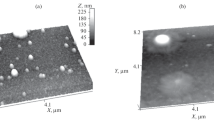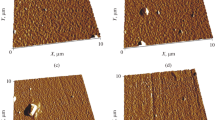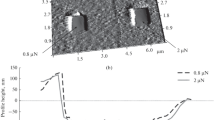Abstract
Results of the atomic-force microscopic determination of the surface microstructure and roughness, friction forces and coefficients of nanocrystalline AlSiN films in the initial state and after annealing are presented. A procedure is proposed to determine the friction coefficients by atomic-force microscopy with multi-pass scanning. The dependences of the friction coefficients on the number of passes are obtained. A significant effect of annealing on a decrease in the friction coefficients of AlSiN films is detected.
Similar content being viewed by others
Avoid common mistakes on your manuscript.
INTRODUCTION
The nanostructured state of films, on the one hand, causes significant enhancement of their mechanical and functional properties. On the other hand, an excess of surface energy at the interfaces promotes the transition of a nanostructure to the nonequilibrium state, which (in turn) can cause the mechanical degradation of films, especially at elevated temperatures in open air [1, 2]. These working conditions will maintain the course of oxidation reactions and as a rule, degradation of the physical-mechanical properties of coatings [3]. Materials based on aluminum nitrides are optimal for operation under conditions of elevated temperatures and mechanical loads [4–6]. Additions of Si atoms to AlN in the amount of 6 at % facilitate the creation of nanocrystalline structures, whereas an increase in the silicon concentration to 30 at % results in the appearance of coatings with an amorphous structure, formed due to the fact that the growth of aluminum-nitride crystallites is limited by silicon atoms [2].
For thin coatings operating under friction-contact conditions [7–10], the tribological properties are important. Moreover, the tribological characteristics enable the highly sensitive control of phase changes in the surface layer, the consequence of which is a change in the friction forces and coefficients Cfr [11]. Upon the action of dynamic mechanical loads, tribochemical transformations occur on the film surface, which affect its tribological characteristics [12]. The exploitation of these coatings can proceed at elevated temperatures, which also causes changes in the phase composition of the surface layers.
Tribotests of these films must be performed with loads that do not deform the substrate and do not cause exfoliation of the coating. Atomic-force microscopy (AFM) is an indispensable tool for these objects, allowing estimation of the surface morphology in the initial state and determination of the force and Cfr of the surface layer without destroying the film [13, 14]. AFM control software makes it possible to set different scanning rates, create a force impact on the surface in the range from nN to mN [15]. The possibility to select the probe-tip radius and material provides attainment of the required mechanical stress in the surface layer [16]. Application of the multi-pass (up to 1000 passes) scanning technique enables changes in the forces and Cfr with time to be controlled directly upon the action of the friction load causing, according to [14], surface oxidation.
In this work, by means of AFM we determine the surface microstructure and roughness, the forces and Cfr of nanocrystalline (NC) and amorphous (A) AlSiN films by single- and multi-pass scanning. The samples are tested in the initial state and after thermal annealing.
EXPERIMENTAL
AlSiN coatings were formed on (100) single-crystal silicon substrates by the reactive magnetron sputtering of aluminum and silicon targets in Ar + N2 plasma [3]. The Al and Si ratio in the coatings was changed by varying the power on the respective targets. In the work, we analyzed samples containing 6 and 30 at % Si. As was found in previous studies [2, 17, 18], the 6‑at % Si concentration resulted in the formation of the NC structure of AlSiN films, and the 30-at % Si concentration resulted in the formation of an A structure. The thickness of the coatings determined from cross sections of the samples was about 300 nm. The coatings formed were annealed in a muffle furnace and under vacuum conditions at 400–900°С for 1 h.
In the case of single-pass scanning the forces and Cfr were determined in five 20 × 20 µm regions. We compared the samples of A and NC films in the initial state, after annealing in vacuum, and after annealing in air. In the case of multi-pass scanning the forces and Cfr were continuously determined in one 20 × 20 µm region during 200–600 scanning cycles at a load of 200 nN and a scanning rate of 17 µm/s. The studies were performed with the use of an NT-206 AFM (Belarus). The tribological characteristics of the AlSiN films were determined by a V-shaped NSC11 (MicroMasch) probe with a console stiffness of 3 N/m and a specially blunted tip with a diameter of 100 nm. The surface morphology and roughness were examined with the use of beam probe (CSC 38,MicroMasch) with a tip radius of 10 nm and a console stiffness of 0.08 N/m.
The forces and Cfr were found in accordance with the twist angle of the probe in contact with the surface [14]. We compared the samples of A and NC films in the initial state, after annealing in vacuum, and after annealing in air. The technique enables the analysis of the effect of surface-phase formation on the friction process in the real sliding mode with the highest resolution.
RESULTS AND DISCUSSION
Optical microscopy images of the surfaces of NC and A AlSiN films after annealing at 400–900°C in vacuum and air do not reveal any morphological changes in the films. Changes in the morphology after each annealing temperature are effectively revealed by AFM (Fig. 1). According to the AFM data, the NC AlSiN films have a polycrystalline structure consisting of ~200 nm crystallite grains with a homogeneous composition. These grains comprise the main background of the surface. Crystallites of the upper layer with a size of ~500 nm are viewed against this background (Fig. 1a). In the A coating separate crystallites with a diameter of 500 nm are viewed against a smooth background. These crystallites are organized in lines with regard to the preferred orientation of the substrate (Figs. 1c, 1d). Due to the effect of annealing in vacuum in both NC and A coatings the crystallites are enlarged, and in both types of films, large crystallites are arranged in lines (Fig. 1b). Annealing in air introduces fine grains with a diameter of 20−40 nm into the surface structure, which can be explained by the formation of new phases (Figs. 1e, 1f).
AFM images of the surface morphology: (a) NC film with a Si concentration of 6 at %, (b) A film with a Si concentration of 30 at %, (c) NC film with a Si concentration of 6 at % after annealing in vacuum at T = 900°С, (d) A film with a Si concentration of 30 at % after annealing in vacuum at T = 900°С, (e) NC film with a Si concentration of 6 at % after annealing in air at T = 900°С, (f) A film with a Si concentration of 30 at % after annealing in air at T = 900°С.
The results of Cfr determination by the single-pass scanning in NC and A AlSiN films after annealing in vacuum show that if in the NC films the dependences of Cfr and the roughness on the annealing temperature are similar, then it is not observed for А films (Fig. 2). According to the powder X-ray diffraction data given in [3, 17, 18], the phase composition of AiSiN films after annealing in vacuum does not change for NC films either and represents a hexagonal AlN phase whose peaks are observed in the diffraction patterns. Phases containing silicon were also not detected by single-crystal X-ray diffraction, however, due to the presence of nitrogen atoms in the coating and with regard to a relatively high enthalpy of formation (ΔH(Si3N4) = –745 kJ/mol, ΔH(AlN) = –319 kJ/mol), the formation of silicon nitride Si3N4 with an A structure should be expected. For A films the diffraction patterns also do not change after annealing. Since these films are X-ray amorphous, it seems impossible to determine their phase composition by this method both before and after annealing in vacuum. The absence of correlation between Cfr and the surface roughness for А films at the same phase composition indicates that Cfr are mainly affected by adhesion forces localized at grain boundaries in the coatings.
The Cfr values determined by the single-pass scanning of NC and A films of the AlSiN system after annealing in air (Fig. 3) are 0.07–0.23 and are similar for the NC and A forms, while at the macro scale the Cfr values differ up to 2.5 times and amount to 0.5–0.6 for NC and 0.2–0.3 for A films [3]. Close Cfr values at the micro scale are explained by a similar phase composition in the surface layers and a similar roughness. However, there are differences in the dependences of Cfr on the annealing temperature for films of both types. Thus, changes in Cfr of А films depending on the annealing temperature correlate well with the dependence of the roughness on the annealing temperature (Fig. 3), which is evidence of a similar phase distribution over the surface at all annealing temperatures.
For NC films annealed in air such a good correlation between Cfr and the roughness is not observed (Fig. 3), which may indicate the dependence of Cfr on the phase composition in NC films, a heterogeneous phase distribution on the surface as compared to the A films, and the localization of water at the interfaces. The obtained Cfr values for the NC films are associated with the surface morphology and its phase composition [3, 17, 18].
By means of the AFM multi-pass scanning technique for AlSiN NC films it is found that the initial film has Cfr of 0.18–0.30 during 50 cycles (Fig. 4). Then Cfr abruptly decreases to 0.17 and does not change up to the 115th cycle. The film subjected to annealing in air at 900°С initially has a lower value Cfr = 0.05 which increases to 0.17 and then remains unchanged. The relatively high Cfr value after annealing of the NC coatings at 900°С in vacuum as compared to annealing in air (Fig. 4) is related to the fact that annealing in vacuum does not cause phase transformations in the NC coatings and the formation of oxide phases [3, 17, 18]. Only the coalescence of separate grains into larger aggregates is observed, which increases the surface roughness. In the first 50 cycles the dependence of Cfr on the path length in the AlSiN coating after annealing in vacuum is very close in value to those of the initial film. Then it abruptly decreases and after 60 cycles completely coincides with the dependence of Cfr on the path length for the AlSiN film after annealing in air at 900°С. The similar course of the curve can be explained by that the surface layer of the initial AlSiN coating having smaller crystallites (Fig. 1a) is more easily deformed by the AFM probe than larger crystallites annealed in vacuum (Fig. 1e). For smaller grains tribocontact with the same normal load creates great contact stresses which in turn lead to the formation of oxide phases. This is why the Cfr values so closely coincide for AlSiN coatings after thermal annealing in air, where oxide phases are already present, and the initial NC films after 60 cycles of friction load.
AlSiN А films are characterized by a lower Cfr value as compared with NC films and a smaller difference in the values of the initial films and those annealed in vacuum and air, but they have the lowest Cfr value for the films after annealing in air at 900°С (Fig. 5). The further decrease in Cfr for the AlSiN A film can be explained by the formation of a secondary structure under friction load on the oxidized surface of the film having a fine nanoscale structure (Fig. 1f). Thus, the oxide phases formed on the film surface after annealing facilitate the formation of secondary structures during contact and decrease Cfr. Annealing in air facilitates improvement of the tribological properties of the surface of the AlSiN film despite the increasing roughness.
CONCLUSIONS
As a result of studies of the tribological properties of the surface of thin AlSiN films by the AFM multi-pass scanning technique it is established that annealing can be an efficient procedure to control these properties. Annealing in air causes a greater decrease in the friction coefficient than annealing in vacuum. Oxide phases formed on the film surface as a result of annealing enable the easier formation of secondary structures during contact and decrease Cfr. Annealing in air facilitates improvement of the tribological properties of the surface of the AlSiN film despite an increase in the roughness. After the AlSiN films were annealed in air for one hour, the friction coefficient was 0.17 in the 120th cycle for NC films and 0.07 for A films.
REFERENCES
A. I. Gusev, Usp. Fiz. Nauk 168 (1), 55 (2013).
J. Musil, M. Šašek, P. Zeman, et al., Surf. Coat. Technol. 202, 3485 (2008). https://doi.org/10.1016/j.surfcoat.2007.12.024
V. I. Shimanskii, N. T. Kvasov, T. A. Kuznetsova, et al., in Proc. 12th Int. Conference “Interaction of Radiation with Solids” (VITT-2017) (Minsk, 2017), p. 420.
D. McIntyre, J. E. Greene, G. Hakansson, et al., J. Appl. Phys. 67, 1542 (1990). https://doi.org/10.1063/1.345664
K. Kutschej, et al., Surf. Coat. Technol. 200, 2358 (2005). https://doi.org/10.1016/j.surfcoat.2004.12.008
A. Pélisson-Schecker, H. J. Hug, and J. Patscheider, Surf. Coat. Technol. 257, 114 (2014). https://doi.org/10.1016/j.surfcoat.2014.08.053
A. I. Komarov, Fiz. Khim. Obrab. Mater., No. 4, 45 (2016).
M. Andreyev, L. Markova, T. Kuznetsova, et al., Vacuum 78 (2–4), 451 (2005). https://doi.org/10.1016/j.vacuum.2005.01.067
M. A. Andreev, T. A. Kuznetsova, L. V. Markova, et al., Frict. Wear 22 (42001), 423 (2001).
T. A. Kuznetsova, M. A. Andreev, and L. V. Markova, Frict. Wear 26 (5), 521 (2005).
T. Kuznetsova, T. Zubar, S. Chizhik, et al., J. Mater. Eng. Perform. 25 (12), 5450 (2016). https://doi.org/10.1007/s11665-016-2390-z
S. A. Chizhik, Z. Rymuza, V. V. Chikunov, et al., Recent Advances in Mechatronics, Ed. by R. Jabłoński, (Springer, Berlin, 2007), pp. 541–545. https://doi.org/10.1007/978-3-540-73956-2
V. M. Anishchik, V. V. Uglov, A. K. Kuleshov, et al., Thin Solid Films 482 (1–2), 248 (2005). https://doi.org/10.1016/j.tsf.2004.11.153
T. A. Kuznetsova, T. I. Zubar, V. A. Lapitskaya, et al., IOP Conf. Ser.: Mater. Sci. Eng. 256 (012022) (2017). https://doi.org/10.1088/1757-899X/256/1/01202210.1088/1757-899X/256/1/012022
T. A. Kuznetsova, N. V. Chizhik, and T. I. Shiryaeva, Prib. Metody Izmer., No. 1 (6), 41 (2013).
B. Bhushan, Nanotribology and Nanomechanics, An Introduction (Springer, 2008).
V. V. Uglov, V. I. Shimanskii, G. E. Remnev, et al., in Proc. 46th Int. Tulinov Conference on Physics of Charged Particles Interactions with Crystals (Moscow, May 31–June 2, 2016), p. 132.
ACKNOWLEDGMENTS
The work was supported by the State Programs of Scientific Research “Energy Systems, Processes, and Technologies” of the Subprogram “Efficient Thermophysical Processes and Technologies” of the National Academy of Sciences of Belarus.
Author information
Authors and Affiliations
Corresponding author
Additional information
Translated by L. Chernikova
Rights and permissions
About this article
Cite this article
Kuznetsova, T.A., Zubar, T.I., Lapitskaya, V.A. et al. Atomic-Force Microscopy in the Study of the Tribological Characteristics of Thin Al−Si−N Coatings. J. Surf. Investig. 13, 36–40 (2019). https://doi.org/10.1134/S1027451019010117
Received:
Revised:
Accepted:
Published:
Issue Date:
DOI: https://doi.org/10.1134/S1027451019010117









